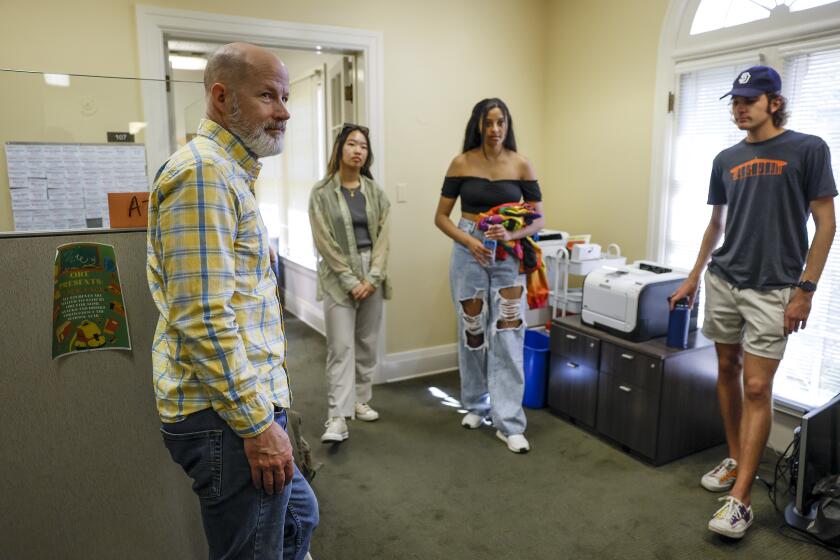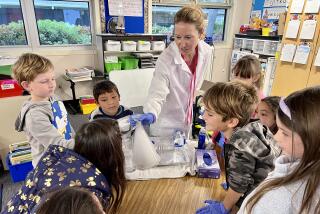Caltech’s latest STEM breakthrough: Most of its new students are women

The auditorium was packed with hundreds of high school girls from across the nation fangirling a YouTube idol they dream to emulate.
There before them stood Katie Bouman, an associate professor of computing and mathematical sciences, electrical engineering and astronomy at Caltech in Pasadena, showing off images of a dark hole ringed by a fire-colored halo. In 2022, Bouman co-led a team of more than 300 researchers from 80 institutions to capture the world’s first image of the supermassive black hole at the center of the Milky Way galaxy.

Bouman’s lecture, part of the Caltech Women in STEM program, had a deeper motive: It showcased a leading woman scientist to help girls envision themselves attending one of the world’s preeminent institutions of science and engineering — fields still dominated by men. And the efforts in this hard-fought, strategic campaign are paying off.
In a milestone breakthrough, more than half of Caltech’s incoming undergraduate class in the fall will be women for the first time in its 133-year history. The class of 113 women and 109 men comes 50 years after Caltech graduated its first class of undergraduate women, who were admitted in 1970.
“What this means for young women is that we are a place that can be representative of them and their experiences ... where they can grow and thrive and excel and become really impressive, extraordinary scientists and engineers and go on to make a difference in this really research-heavy profession,” said Ashley Pallie, dean of admissions.

Gloria L. Blackwell, chief executive of the American Assn. of University Women, lauded Caltech’s achievement as crucial progress in reducing the substantial gap of women in science, technology, engineering and math. Although women hold about 60% of degrees in biological sciences, they represent only about 18% in computer science and 20% in engineering, Blackwell said.
Research has shown that boys are not better at math and science than girls, but a persistent message in society says otherwise — and especially discourages Latinas and Black girls from pursuing the fields because they face discrimination and have less access to role models, resources and opportunities, the AAUW says.
Caltech is dropping requirements for high school calculus, chemistry and physics courses for students without access to them and will offer other ways to demonstrate knowledge in those fields.
Caltech isn’t the first educational institution to reach gender parity in STEM. Harvey Mudd College, a small private institution in Claremont, was an early leader in diversity — a key goal of former President Maria Klawe, a computer scientist and mathematician who stepped down last year after a 17-year tenure. The college enrolled more women than men in 2010 for the first time in its history and in 2014 graduated more women than men in engineering. Today, women make up 52.8% of majors in computer science, 50.5% in engineering and 68.2% in mathematical and computational biology.
At UC Berkeley, another powerful producer of STEM graduates, nearly half of students majoring in those fields identify as women or nonbinary, but the field they enter varies significantly. They make up more than two-thirds of students in biological and biomedical sciences, but about one-third in engineering, computer and informational sciences, and mathematics and statistics.

The long quest for gender parity
For Caltech, a campus of 2,400 undergraduate and graduate students with 47 Nobel awards and more than 50 research centers, the road to gender parity has been long. Women were not admitted until 1970 amid rising demands for gender equality and two years before Congress passed Title IX of the Higher Education Act, which prohibits discrimination on the basis of sex in any educational program receiving federal funds.
Louise Kirkbride was one of 32 members of that inaugural class. A Philadelphia teen and National Merit finalist scouted by Caltech, Kirkbride wanted to attend the institute so badly that she left home for Pasadena without her parents’ permission or support. Institute officials picked her up at LAX, gave her a full scholarship and helped her become an independent minor, Kirkbride said.
“In my mind, Caltech was the hardest school to get into in the world and that made it just kind of irresistible,” said Kirkbride, who went on to found two venture-capital-based startups and currently serves as a Caltech trustee.
On her first day, she said, some male students held up a sign, “Welcome, Kotex,” referring to a tampon brand. She put up with a student who carefully explained “why it had to be true that [women] were admitted as affirmative action” based on the purportedly natural gender distribution of intelligence. One professor said to her class that admitting women would end Caltech’s excellence, and another told her that “you’re a waste of an education.”
But the kindness and support of another professor, Carver Mead, helped her find a home at Caltech. She was so inspired by him that she followed his path and became an electrical engineer.

Mead, now 90 and still engaged in research as a professor emeritus of engineering and applied science, said he has always supported women scientists. “I’ve always had women in my research group, and they’re more collaborative and often provide a lot of leadership in a very quiet way, and it just really changes things,” he said.
During the faculty meeting to debate the issue in 1967, Mead said, many of the “old farts” complained that women would feel outnumbered and would just get married and have children and that “we could have educated somebody who was going to do ... science.” He left the meeting and called an MIT woman graduate he knew. She told him she had had no problems being a minority at the Cambridge, Mass., campus. Mead returned, told his colleagues about his “data point” and, as scientists persuaded by evidence, they voted to let women in.
By the time Bouman reached Caltech in 2019 as a faculty member, much had changed. Growing up in Indiana, she was always encouraged to pursue her talent in science and math by her father, a professor of electrical and computer engineering and biomedical engineering at Purdue University. But as an undergraduate at the University of Michigan, she was just one of a handful of women in the electrical engineering department and sometimes felt like an impostor.
“That starts to get in your head a little bit, but if you don’t search for it, then you can kind of just plow forward and not let it worry you,” Bouman, 35, said. “I really tried to put blinders on.”
She graduated summa cum laude from Michigan, earned her doctoral degree at MIT, where she first started her work on black hole imaging in 2013, then became a postdoctoral fellow at Harvard. There, in 2019, she helped develop the code to capture the world’s first image of a black hole and unexpectedly became the face of the international project when a photo of her amazement hit social media. U.S. Rep. Nancy Pelosi (D-San Francisco) hailed her as “an inspiration to all Americans and especially to young women and girls” with STEM dreams. Children sent her their drawings of black holes. One girl even dressed up as her for Halloween.
Bouman said she never intended to be a role model but recognizes the importance of girls seeing women in the sciences. After her lecture, one girl went up to her, asked to take a selfie and told her, “You’re my dream scientist!”
UC Berkeley has announced plans to open a 36-acre space center at NASA Ames in Silicon Valley to create new opportunities in a fast-growing field.
Leah Cevallos, a West Sacramento high school senior, said the science journals she reads “for fun” are dominated by men, so seeing Bouman centered in the black hole breakthrough was inspiring.
“The more you give people the opportunity to see themselves in a place like Caltech, the more we know we’ll find fantastic people who can make great contributions to science and technology and engineering,” said Michelle Effros, who was the first woman faculty member hired into Caltech’s electrical engineering department in 1994.
Pallie, the admissions dean, said she has more than doubled the size of the Women in STEM program to 500 girls and extended it to two days, so potential students and their families can get a deeper sense of Caltech — especially the lab tours to “let the science speak for itself.”
She also revamped the institute’s messaging to say upfront that Caltech is fearsomely difficult, but also a unique and exciting place for the right person. Applications have skyrocketed from 8,000 before the pandemic to 14,000 today. The admission rate has fallen to 3.14%, and the share of students accepting admission offers has increased to 64%.
Pallie said there is still work to do.
“You can’t just be a one-hit wonder,” Pallie said. “Our major goal is to sustain and continue it so this is just part of the DNA of Caltech, that we just are a place where young women see themselves and they know that they can really thrive.”
More work ahead
But even as more women study science, technology, engineering and math, they remain significantly underrepresented in the related workforce. Women hold about 45% of STEM degrees but make up only 28% of the workforce in those fields, said Blackwell of the American Assn. of University Women. Many women face unwelcoming “masculine cultures,” she said, and some experience gender discrimination and opt to leave the field.
But during Caltech’s Women in STEM day, it was all dreams of cutting-edge research and new scientific discoveries.
Miranda Li, a senior at Sierra Canyon High School in Chatsworth, is passionate about astrophysics and astronomy, relieves stress by doing complex math problems and is writing a play about physics. Her tour of a lab that measures gravitational waves was “really cool,” cementing Caltech as one of her top college choices.
Veronika Voss is a member of this year’s milestone class of majority women. She grew up in a rural Minnesota town amid fields of corn and soy. Her tiny high school — graduating class, 68 students — had no Advanced Placement courses and limited offerings of advanced math and science, so she studied on her own with old textbooks and online resources, such as Khan Academy. She gained hands-on experiences with electronics fixing her family’s electrified chicken fence, the engine in her tractor lawnmower and is training as a helicopter mechanic.
To Voss, taking apart engines and figuring out the problem is like solving complicated math equations — both bring her joy.
And so does Caltech, she said. She learned about the institute as a child fascinated by space who followed the work of the Jet Propulsion Laboratory, which Caltech founded and manages. Then she was invited to attend the Women in STEM program. The experience sealed the deal for her to attend Caltech.
“I came to campus and it was like 500 women; I was like, oh my gosh, it is a real place and there’s so many women who are here and they’re all insanely passionate about the same things that I’m very passionate about,” Voss said.
More to Read
Sign up for Essential California
The most important California stories and recommendations in your inbox every morning.
You may occasionally receive promotional content from the Los Angeles Times.









